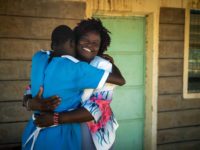One morning three years ago, Gita was shocked by the sudden contractions she was experiencing. She knew it was time for her baby to come, but the 20-year-old had never given birth, had never seen anyone give birth and did not know how to deliver her child.
Gita would have had to walk 30 minutes to reach the hospital. But even if she made it in time, she couldn’t afford the bill. She felt she had no choice but to give birth at home. The only person who could help was her oldest sister, who was visiting her at that time.
Gita’s sister, who had experience in helping people give birth, prepared a razor blade, to cut the umbilical cord, and a bucket of cold water.
As Gita lay on her grass bed, her sister pressed Gita’s belly with both hands while Gita strained to deliver the child. Thankfully, Gita didn’t have to push too much.
After successfully delivering the child, Gita’s sister used the razor blade to cut the umbilical cord. Then she cleaned up Gita’s son by washing the baby with cold water and drying him with a towel. Gita took a bath with cold water to clean herself.
 In this way, Gita delivered her first baby, Martin, at home without medical assistance. Her at-home delivery is typical among women in Indonesia’s Papua province.
In this way, Gita delivered her first baby, Martin, at home without medical assistance. Her at-home delivery is typical among women in Indonesia’s Papua province.
Most Papuan women still give birth with traditional methods in a honai – a traditional Papuan house made of wood with a grass bed.
Women also prefer to give birth at home because they are afraid of the service from health workers who are not always friendly. Many women believe that it is more efficient to give birth at home alone or with help of someone who lives nearby.
Though these traditional methods of delivery have been going on for years, they are risky. Although some say no children in the area have died after a home birth, 2009 data from the Central Bureau of Statistics in Jayawijaya regency reveals that, since 2004, 167 babies have died after their mothers delivered them without medical assistance.
Numerous factors lead women to deliver their children at home. In Gita’s case, her husband is jobless. The family relies solely on what she earns working at a farm every day. (In Papuan culture, the responsibility of earning money often falls on the women.)
Since enrolling in the Child Survival Program (CSP), Gita now knows that giving birth at home without any medical assistance could put her and her baby’s lives at risk. This woman, who only reached the first year of senior high school, has now learned how to safely deliver her baby. She’s learned that she has to check her pregnancy regularly, to recognize contractions, and the importance of using clean instruments during delivery.
“We taught them to understand the danger of delivering at home and the benefit of giving birth with medical assistance.
“Registered mothers at first didn’t have a good understanding about pregnancy and how they can give birth safely. It was very hard to change their paradigm about how to deliver in an appropriate way.
“They still believe that delivering the baby in the honai will not put their self in risk. They also thought it is more efficient than if they have to see the doctor to help them deliver their baby.
“Pregnant mothers now know that they have to protect their pregnancy in a good way. They learn to show their love by taking care of their pregnancy,” explains Antonetta, the CSP coordinator.
Gita, who is now pregnant with her second child, passes on the blessing of Compassion to other women. She loves to share her pregnancy experience with other mothers who haven’t had the opportunity to join the program. She wants to make a positive impact on mothers so they can they safely deliver their babies.







8 Comments |Add a comment
@Kelly, did you bother to research what Compassion’s Child Survival Program actually does before writing your post defending home birth? Through the CSP, “pregnant mothers receive regular prenatal care. In a community where many mothers cannot afford medical care, the Child Survival Program ensures that each mother has access to a trained birth attendant or doctor during delivery of her baby.” At home. They don’t teach that home birth is dangerous, they teach under what circumstances that it can be unsafe for both mother and baby. The purpose is to help mom’s with ZERO knowledge of being pregnant / giving birth have a safe delivery at home. Good for you for having a home birth, with all your books and prenatal classes you have a wealth of knowledge to have a safe delivery. All Compassion is doing is trying to provide the same thing for women who don’t have access to this information. This isn’t the forum to defend home birth.
Calm down, it was just a misunderstanding. So she might not have known all the details of what the CSP does before reading the article. All that was needed was an explanation without the impatient wording woven in. =)
“Calm down?” My post was straightforward and to the point, explaining what the article was really about. I wasn’t the one ranting about how safe home births are and how many I’ve had, I was explaining that that’s what the CSP promotes: safe. home. births. Kelly’s a big girl and can defend herself.
@Susan, I am not trying to defend homebirth, but trying to provide some ideas to make it safer for women & babies. This article seems to say that it is the hospital or the highway, & maybe that’s not the intention. I think what we both want is to see women properly educated & the resulting safe outcomes for births.
While I agree that giving birth without adequate prenatal care, unclean instruments & or experienced attendant is risky, all these things can be present at a home birth. Why not bring in trained midwives to train local women how to become midwives & to do things safely? That would provide local pregnant women with more easily accesible, & probably less expensive care & the newly trained local midwives a good source of income. They site the statistic of 167 infant death since 2004 after home births, what are the statistics of deaths after hospital births? Home birth in itself is not inherently dangerous & should not be taught as such. I’m speaking as a US citizen woman who has had one hospital birth & one home birth & am planning my second home birth. Studies have shown, for low risk women (identified through good pre-natal care) home birth with an experienced attendent is as safe or safer than hospital birth.
I completely agree, Kelly! I have had 2 hospital births, and most recently a home birth. I definitely agree that this is the safest option for a low-risk pregnancy, and training local midwives would be great for the community!
These women are an inspiration! We have so many luxuries in this country that I take for granted. Thanks for reminding me of this.
Love this post. It really shows what is possible when the body of Christ gathers together and brings in resources. It can really make all the difference.